



Join us for the workshop that is also a game where we use roleplay to explore how personal and collective data practices and devices might shape the attitudes and fortunes of a society?
Sign up by 12th August 2020
Participants will each receive one of two devices in the post, and will be given different roles to play as delegates in a fictional trade negotiation. In this first meeting on record, and with minimal knowledge of each other’s cultures, the people of Ourland and New Bluestead must use their devices to communicate with each other and to agree to the terms of a technology and data-culture exchange.
What do they have to offer? How will they decide what they want and what is in their best interests?
What freedoms might they sacrifice, what insights might they gain?
How might they adapt a foreign technology to their own needs, and how might they understand the risks involved?
This is an invitation to participate in Transcultural Data Pact, a research event that is also a game of serious make believe. We welcome you to a future-historic event and clash of data-cultures.
The event will take place online in Zoom and will last for about 3 hours with a lunchtime pre-event orientation session that will last for an hour.
There are two sessions available for both the game event and the pre-event orientation (which is a requirement of participation):
Lunchtime pre-game orientation events
13.30 – 14.30 BST Tues 18 August 2020
13.30 – 14.30 BST Wed 19 August 2020
Transcultural Data Pact Game events
13.15 – 16.30 BST Thurs 20 August 2020
13.15 – 16.30 BST Fri 21 August 2020
In exchange for your time you will exercise your creative agency contributing to the ideation of future technologies for live personal data. You might even discover new meanings in your personal data in places you never thought of looking before!
All participants will receive a £20 voucher for their contribution to the research.
This is an open invitation to all. No experience in role-playing games is necessary.
Pregame orientation events
13.30 – 14.30 to learn about your devices and about LARPing, to introduce and develop the scenarios, to build the fictional worlds together.
Game Event Schedule
13.20 – 13.30 Arrive in Zoom and sign in
13.30 Introduction
13.40 – 16.00 Nations Technology Exchange Live Action Role Play
16.00 – 16.30 Debrief, reflection and survey
For any enquiries, please email ruth.catlow@furtherfield.org
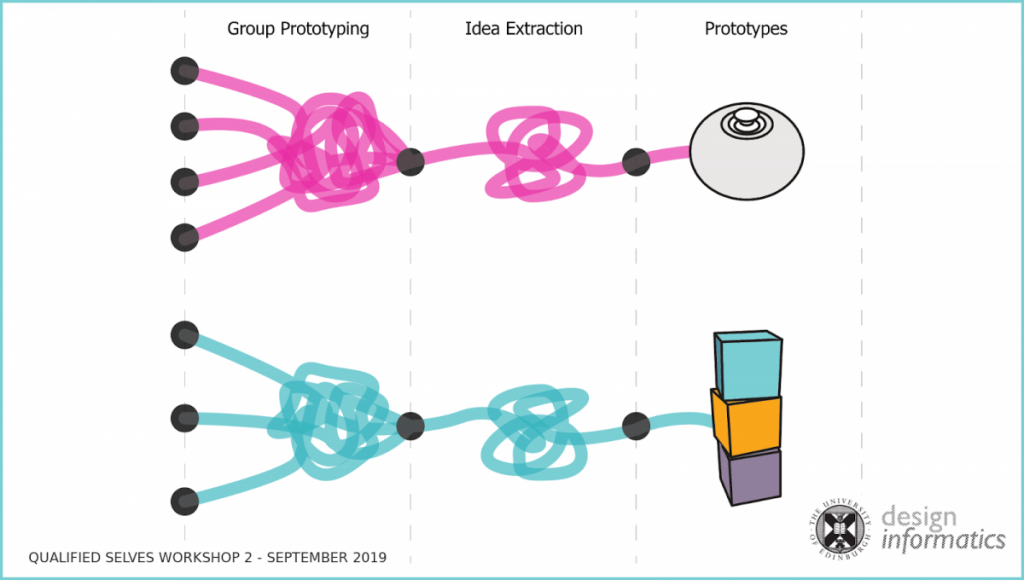
Findings contribute to a research paper Human-Computer Interaction (CHI).
The Transcultural Data Pact is a Qualified Selves research event that uses data objects to stretch people’s imagination about the collection and usage of their own data to investigate personal and collective data devices and practices that add real value.
Qualified Selves is a joint project between Lancaster and Edinburgh Universities. Improving how individuals make sense of data management (from social media to activity trackers to home IoT devices) in order to enhance personal decision making, increase productivity, and improve their quality of life. Its novel approach to co-design and co-creation has supported the development of new prototypes to help think about tracking data in different ways. https://sensemake.org/
Transcultural Data Pact is created by Ruth Catlow (Furtherfield/DECAL) with Dr Kruakae Pothong, Billy Dixon, Dr Evan Morgan and Prof. Chris Speed from Edinburgh University, in collaboration with Kate Genevieve.
Ruth Catlow is Director of DECAL. Furtherfield is London’s first (de)centre for digital arts. DECAL is a Furtherfield initiative which exists to mobilise research and development by leading artists, using blockchain and web 3.0 technologies for fairer, more dynamic and connected cultural ecologies and economies.
Our times are characterized by the accelerating collapse and redrawing of multiple borders: between nation states, personal identities, and the responsibilities we have for each other. Also between the old distinctions, work and pleasure.
Some leaders as part of the new world order, tell us through their political actions and their fashion accessories, that they “Just Don’t Care”. This “political art-form”[note]Rebecca Solnit: Not Caring is a Political Art Form: On Melania Trump and the Politics of Disconnection lithub.com/rebecca-solnit-not-caring-is-a-political-art-form/[/note] of not caring permits an insidious spread of hatred online and on the ground. In recent times, the digital condition has lent it’s networks and platforms to this poisonous, rhetorical hyperbole, turning against immigrants, and others who do not fit into the framework of a western world, oligarch orientated vision. Mass extraction and manipulation of social data has facilitated the circulation of fake news and the production of fear, anxiety and uncertainty. Together these fuel the machine of structural violence adding to the already challenging conditions created by Austerity policies, growing debt and poverty.
In the face of these outlandish difficulties our digital tools and networks – taken up with a spirit of cultural comradeship. More inspiring narratives are emerging from across disciplines and backgrounds, to experiment with new solidarity-generating approaches that critique and build platforms, infrastructures and networks, offering new possibilities for reassessing and re-forming citizenship and rights.
The exhibition and labs for Playbour – Work, Pleasure, Survival, have created new contexts for collaboration. Artists (from the local area and internationally), game designers and architects, come together with researchers from psychology and neuroscience addressing the data driven gamification of life and everything.
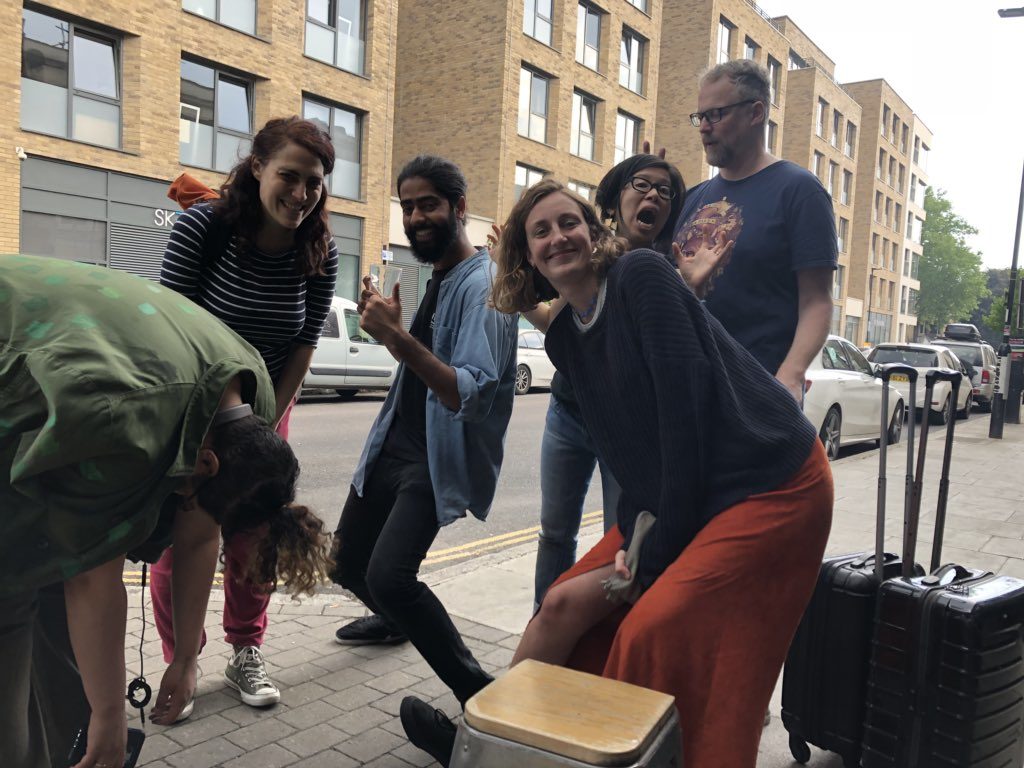
In her interview, the curator Dani Admiss discusses how they reassess the power relationships of the gallery, park users and the local authorities, asking who owns the cultural infrastructure and public amenities – and so create a polemic to open up questions of public value. The exhibition is open every weekend through 14 July to 19 August 2018.
The artists featured in Transnationalisms exhibition curated by James Bridle address the effect on our bodies, our environment, and our political practices of unstable borders.
“They register shifts in geography as disturbances in the blood and the electromagnetic spectrum. They draw new maps and propose new hybrid forms of expression and identity.”[note]Transnationalisms. Aksioma – Institute for Contemporary Art, Ljubljana, Slovenia.
aksioma.org/transnationalisms/[/note]

“Thiru Seelan, a Tamil refugee who arrived in the UK in 2010 following detention in Sri Lanka during which he was tortured for his political affiliations, dances on an East London rooftop. His movements are recorded by a heat sensitive camera more conventionally often used to monitor borders and crossing points, where bodies are identified through their thermal signature.”[note]Regine Debatty. We Make Money Not Art. Democracy, locative, politics, Transnationalisms – Bodies, Borders, and Technology. Part 1. The exhibition. May 14, 2018. we-make-money-not-art.com/transnationalisms-bodies-borders-and-technology-part-1-the-exhibition/[/note]
The show opens at Furtherfield from September 14th to October 26th 2018, touring as part of State Machines the EU cooperation which investigates the new relationships between states, citizens and the stateless made possible by emerging technologies.
We have another interview with artist and activist Cassie Thornton, where we discuss her current project Hologram, which examines health in the age of financialization, and works to reveal the connection between the body and capitalism. Her interview focuses on a series of experiments that actively counter the effects of indebtedness through somatic – or body – work including her focus on the way in which institutions produce or take away from the health of the artists and workers they “support”.
“In my work for the past decade, I have been developing practices that attempt to collectively discover what debt is and how it affects the imagination of all of us: the wealthy, the poor, the indebted, financial workers, babies, and anyone in-between.” Thornton
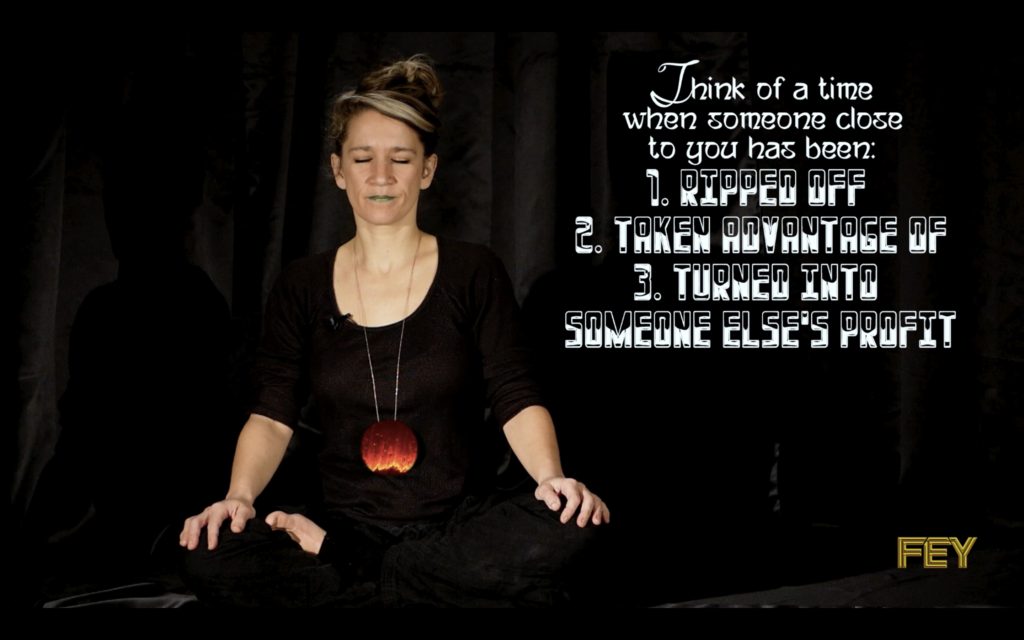
Finally I interview Tatiana Bazzichelli, artistic director and curator of the Disruption Network Lab, in Berlin, questions about art as Investigation of political misconducts and Wrongdoing. Since 2015, the Disruption Network Lab has cultivated a stage and a sanctuary for otherwise unheard and stigmatised voices to delve into and explore the urgent political realities of their existence at a time when the media establishment has no investment in truth telling for public interest.
“When the speakers are with us and open their minds to our topics, I feel that we are receiving a gift from them. I come from a tradition in which communities, networks and the sharing of experience were the most important values, the artwork by themselves.” Bazzichelli.
The programme creates a conceptual and practical space in which whistleblowers, human right advocates, artists, hackers, journalists, lawyers and activists are able to present their experience, their research and their actions – with the objective of strengthening human rights and freedom of speech, as well as exposing the misconduct and wrongdoing of the powerful.
To conclude, all one needs to say is…
“Whether in the variety of human, backgrounds and perspectives, biodiversity or diversity of technologies, coding languages, devices, or technological cultures. Diversity is Proof of Life.” Ruth Catlow, 2018.
Eva Kekou met Tobias Rosenberger at the international e-MobiLArt workshop which took place in Athens, Vienna and Rovaniemi, in turn these led to a number of exhibitions and successful collaborations between artists and theorists. She now invites him to discuss his work, issues of surveillance and how a young European artist views the situation in China and what he expects from his interaction with the Chinese art scene.
Tobias Rosenberger (b. 1980) is a German media artist who works at the crossroads of media art, visual arts, and performance. He has produced art works in Yemen, Spain, Mexico, India, and Ukraine etc. Since 2011 he has been based in China, where he teaches at the College of New Media Art, Shanghai Institute of Visual Art.
“Nowadays, anyone who wants to combat lies and ignorance and to write the truth must overcome at least five difficulties. He must have the courage to write the truth when it is suppressed everywhere; the wisdom to recognize it, although it is concealed everywhere; the skill to use it as a weapon; the judgment to choose those in whose hands it will be effective; and the cunning to spread the truth among such people.” (Bertolt Brecht)
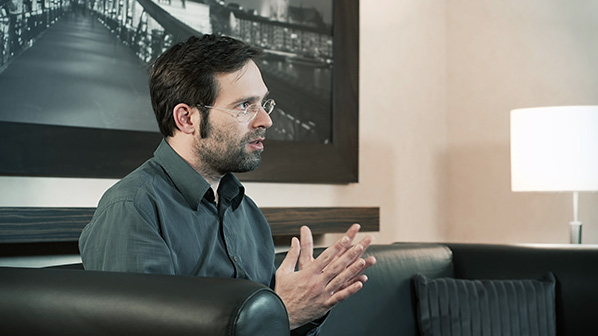
Eva Kekou: I would like to start this interview with this quote which seems to be significant for your work and in particular the recent one – the secret race film and discussion at Goethe Institut Washington. As you well state in your event invite: “It was pure coincidence that for a few days in the summer of 2013, two unrelated events simultaneously dominated the major headlines in the German press: the monitoring and spying scandal of 2013, triggered by Edward Snowden’s leaks of National Security Agency top-secret classified documents, and the official acknowledgement of the prevalence of doping in competitive sports, best symbolized by Lance Armstrong’s televised confession.” What is the significance of surveillance in a globalized social and political context and where is the place of art within it? There are obvious reasons you decided to launch this in Washington through Goethe but I would like you to comment on this.
Tobias Rosenberger: Surveillance and espionage are as old as civilization. Power was always constructed, maintained, and expanded through monitoring, categorising, repressing, and excluding people. We all know that the digital apparatus opens a new world of possibilities to organize, quantify and control life and society in a before unknown scale, speed and efficiency. While I agree that we need early warning models to anticipate and fight cruelty and injustice whenever possible, I don’t believe that we can draw a sharp border between an evil surveillance that fuels unfair and inhuman systems and a necessary one that pretends to save dignity and a lawful order. The challenges of our time can no longer be met by elitism and secretiveness, but require the joint efforts from the middle of society. An independent art that rejects the simple desire for (self-)confirmation does not only open a non-biased discursive space for critical reflection, but it also has the potential to demask and break the mechanisms of power, as long as it takes its audience seriously. But to be able to do so, art also has to find its audience.
EK: It occurs to me that place and space play a very important role in your work and inspiration. How do these relate with each other with pieces of your work in a globalized and mobile network underlined by politics?
TR: I have a very pragmatic approach to what I am trying to do: Not following a specific agenda and always staying as curious and open as possible. This requires both a certain naivety and an observing attitude. I never start an artistic process with a specific idea or question, but i get attracted by places and spaces that i try to discover without too much of my personal baggage. But since space and place are never abstract but segmented by politics both on macro and micro layers, the resulting works often deal with political questions.
EK: How did you become interested in China and what do you find fascinating or difficult working there? Is it interesting for you as a European?
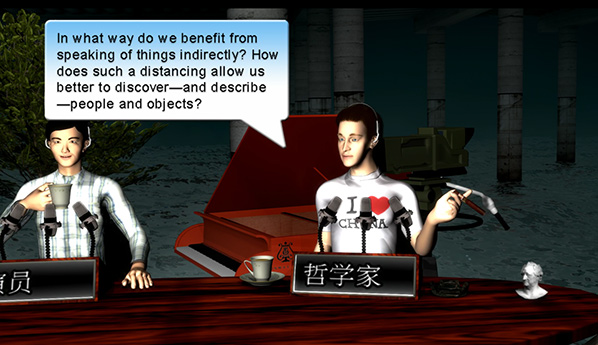
TR: I have a very special relationship to China. With my Chinese wife I decided three years ago to move there and to found a family. I was always fascinated by China as a cultural space, with a tradition of art and philosophy at least as long as in Europe. I also really like the food and the people there. As a foreigner I experience it as very fruitful to see things from a specific distance, both if I try to understand the culture, but also especially if I look back from there to where I come from. It is very interesting to observe the relation between art and politics, how the government here really appreciates art and how it is also afraid of it.

How artists, critics and curators fight for free space, a career, or both. In Shanghai you have both the global economy and the local life at your house-door. The country faces a lot of problems, and very often one can get the impression that things are not happening at all just because there is a small possibility that something unexpected could happen. So many people behave very pro-actively in a way that they won’t run into any problems themselves. But this maxim “to have everything running smooth” you certainly don’t only encounter in China.
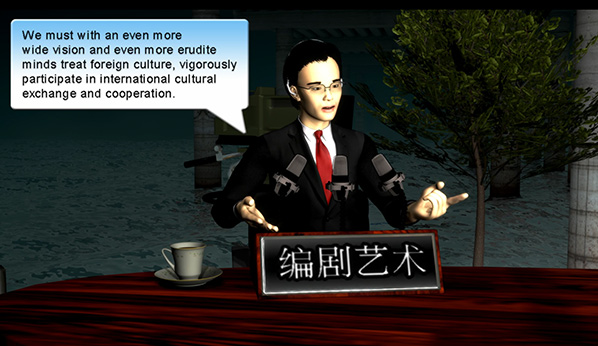
EK: Referring to some of your recent works (installation and performance): Choose any you like… How do you reach out to audiences and what is the main aim in your own work?
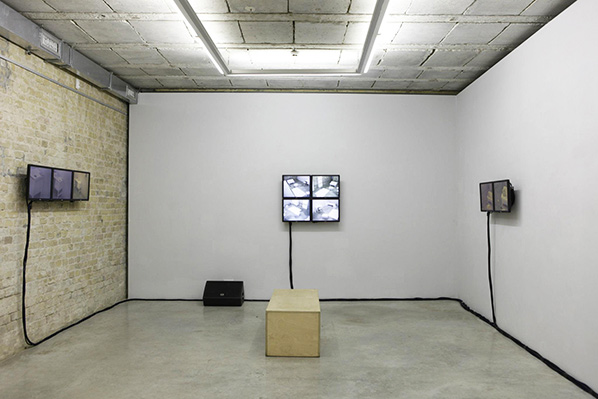
TR: “The First Twenty Years” is an installation that was shown in two different versions at the end of 2012 in Kiev and Dnipropetrovsk. I developed the basic idea for that work in 2011, when I was invited to spend some time in a small Ukrainian village near Kiev at a private artist residency programme. During that time the nation celebrated the 20th anniversary of its independence. There was a strange, partly paralyzed mood. But I also witnessed very controversial discussions with artists, curators and critics, and a new generation that seemed not anymore willing to accept living in a nation that was more and more perceived as a prison. So when I was approached during that time to do a work based on my experiences in the Ukraine, I decided to base it on Xavier de Maistres “Journey around my room” and Schuberts Music, which was inspired by a poem by Christian Friedrich Daniel Schubart.
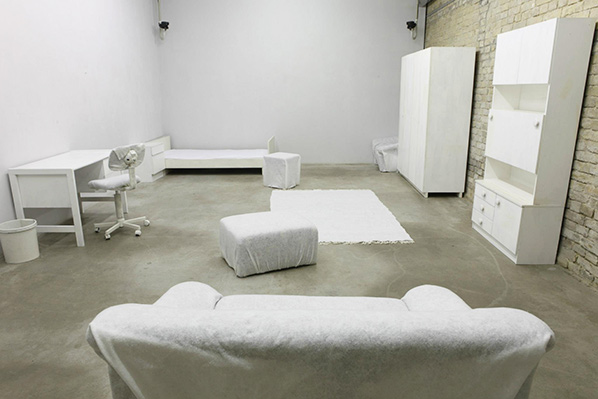
I didn’t intent to comment directly on the situation there, but rather was trying to understand for myself what was happening. For me, art is not about expression but about the creation of a space where everybody is invited to take a bit of distance so to be able discover something from different perspectives and to think in his/her own way.
Surveillance Cameras dancing to Schubert, on Vimeo
EK: Can you give us a bit more information about a project that you have described alsewhere in the following way: “Right now working on a light sculpture for permanent setup in a former WWII Top secret military site, where some crazy NS-Germany scientist wanted to invent an x-ray wonder-weapon to shoot planes and soldiers, this involves an always transforming multichannel-sound installation, motorized miniatures (arduino-controlled), 2 projectors and led-objects. I will make an extra independent video of this work, filmed with multiple moving surveillance cams.”?
TR: I was approached by a cultural initiative that runs today a small history museum in a former research bunker, which was secretly constructed in 1942 / 1943 underneath a camouflage building. I came across a letter in which a certain Professor, Dr. Ernst Schiebold, proposed “An additional weapon to fight and eliminate the crews of hostile airplanes and ground troops in the defensive via x-ray and electron radiation”.
A weird ten pages male war fantasy about a new kind of tubular x-ray canon, written in a crude mixture of physical pseudo-science, soft patriotic enthusiasm and German pedantism. Schiebold really got his bunker built to start with his research. Everything was kept top secret, but stopped 18 months later without results. I decided to bring Schiebold’s proposal back into the space which only existed because of it: As a pure proposal, enhanced and communicated with new media technology.
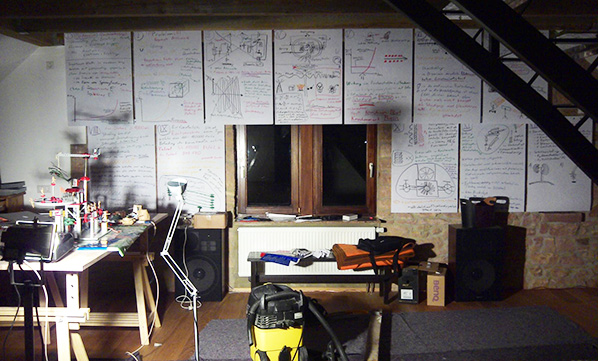
A lot of the tools that we are using as new media artists exist mainly through military development. So my intention was also to give something back. The audience will listen to single sentences that are randomly taken out of Schiebold’s letter and re-arranged into a constantly transforming synthetic sound atmosphere, which is synchronized with light beams crossing a motorized miniature military model. The toy miniatures cast shadows of moving soldiers and airplanes onto the walls. LED lights are flashing out of a tubular manhole, which was originally constructed to be used with a Betatron. All the technology that I use is quite low-budget and geeky. Last week I started to install the parts on site, and I have to admit that it is also a very weird experience for me to spend nights working alone in a former military research bunker, climbing down in a manhole and setting up the mockup of a “super-weapon” people researched in the darkest years of German history. Sure I will also try to document it properly.
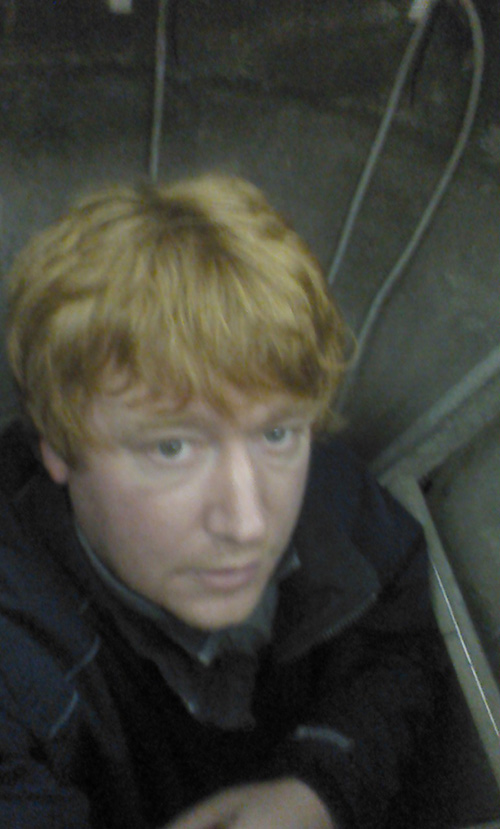
EK: Do you think art can be global and political, if not, what are the main restrictions we are all subjected to? How can art and artists make a difference in this respect?
TR: I think that art is per se political, since it deals with and also influences our perception of reality. And while all our lives are clearly connected in a global economy of good and information-exchange, art does also always operate on a global scale. As an artist I believe that it is worth to be curious and to investigate the (media) apparatuses and dispositifs that surround us, to take them apart and re-design them. What are they good for, what effects do they cause? While the world is getting closer, the world is never the same – people have different histories, problems, possibilities and hopes. As Europeans we take many things for granted, that other people see differently – or vice versa. I think artists can always make a difference, as long as they stay independent and continue to tackle serious questions, but don’t take themselves too seriously while doing so. We should laugh more together.
EK: What are your future aims and plans?
TR: I am looking forward to the new semester in Shanghai, where I will mentor the graduate works of eight students. I will also collaborate with Chinese artist Mujin (Lixin Bao) – a fellow teacher at the Shanghai Institute of Visual Art – on a series of works exploring the notion of the “Chinese Dream” and its perception both nationally and globally. I guess this dialogue will become quite interesting.
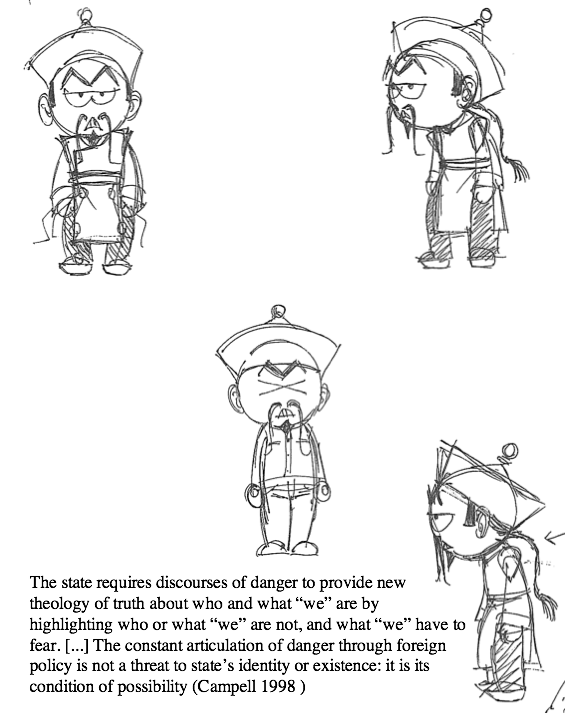
Featured image: Artist Suguru Goto discusses his work.
London 2012: there is of course one event which springs to mind when we think about this city and the year we’re in, but there is also another significant event happening in London right now, one which is very important for the digital and media arts world. It is the year that Watermans Arts Centre is holding the International Festival of Digital Art 2012.
As well as showcasing an array of digital art by internationally renowned artists, the programme also offers the opportunity for members of the public to get involved in discussions around themes that the Festival touches on through the seminar series accompanying the shows. These are in collaboration with Goldsmiths, University of London. Nearly three months in, the Festival has launched two exciting shows,Cymatics by Suguru Goto and UNITY by One-Room Shack Collective.
The first show, Cymatics, is a kinetic sound and sculpture installation that expresses Goto’s vision of nature. To enter it, the audience step through a door into a boxed, dark room within which they are presented with a touch screen interface, a shallow metal tank holding water and a screen showing a video feed of the water in the tank. The piece invites the audience to move the water in the tank by manipulating sound waves via an interactive screen. The result of the interaction is a stunning variety of geometric shapes, demonstrating the distortion that sound waves can have on a substance. This occurrence reveals the bridge between technology and nature, which fits into Goto’s re-occurring theme within his work of the relationship between man and machine.
The seminar which coincided with the show, Interactivity and Audience Engagement, was chaired by Régine Debatty and featured on the panel Tine Bech, Graeme Crowley and Tom Keene, all who which explore audience engagement in different ways within their work. Tine Bech is a visual artist and researcher whose installations invite audiences to engage in playful interactions, from chasing a motion reactive spotlight in Catch Me Nowto sound triggering shoes in Mememe. Tom Keene is an artist technologist whose focus intersects participation, communication and technology. His work is multidisciplinary, investigating the way we communicate, mediated by technology. His practice is diverse, from exploring the potential relationships between networked everyday objects in Aristotles Office to inviting a community to comment on their local issues through signs in Sign X Here. Graeme Crowley is a designer and artist who has created installations for prominent public areas, including The Wall of Light, commissioned by Arrowcroft Plc for the centre of Coventry and Spiral/Bloom commissioned for a hospital in Rochford by the NHS.
I found the juxtaposition of these three practitioners very interesting as each of them explore the interaction between audience and technology in varying ways. Bech’s work is very tactile and sculptural, almost making people forget the technology behind it. She likes to look at technology as something we can mould and which can be used to explore the wider issues which art can bring up, rather than just focussing on the tech itself and how ‘shiny’ (to use her own term) it is. In contrast to this, within Keene’s practice technology feels very prominent, visually as well as conceptually. Crowley’s focus is different again as it mostly operates within the commercial sphere. It therefore is produced for greater public consumption and needs to withstand being a permanent exhibit, becoming part of the architecture it is planted on rather than something which is temporary. The talks given by each panel member and discussions which accompanied them were all diverse and brought up interesting points around the idea of audience engagement and interactivity. Members of the audience entered into these discussions with ease, creating an open dialogue which itself was participatory and engaging.
UNITY, by One Room Shack is the current exhibit as part of the International Festival of Digital Art 2012, bringing a piece of work to the gallery which aims to embody the Olympic spirit, visually as well as conceptually.
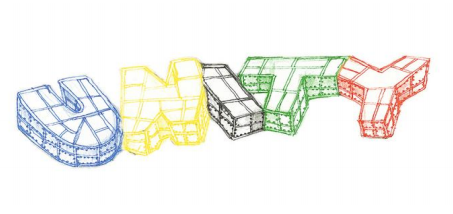
Design for Unity
The installation takes the form of a transparent maze, angular in its structure and illuminated with different coloured LED lights in each section. Each illuminated section of the structure forms a different letter, all together spelling the word ‘unity’. As the audience navigate their way through the installation, their movement is picked up by motion sensors, triggering the LEDs at each point to turn on. These each represent a particular colour of the Olympic rings.
The ideologies of the Olympic Games linked with an immersive space explores the value of ‘being together’, something which the African humanist philosophy Ubuntu also speaks about.
UNITY is effective in exploring the theoretical concepts embedded within it through a playful and simple interactive structure. As an individual you step from section to section with the different groups of LEDs individually illuminating you as you go through the work. When a group of people interact with the piece at the same time however, the piece lights up as a whole, echoing the values of being together that UNITY invites us to explore. It is through enabling this experience, that the work celebrates and explores human connections.
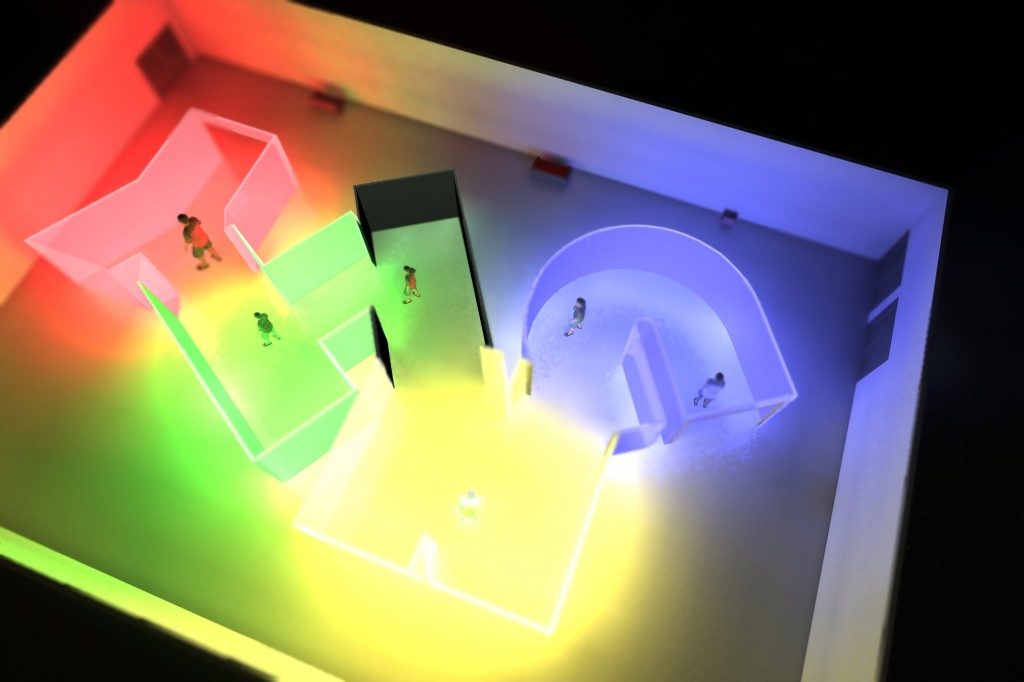
I do find it interesting how the piece has such a strong stance towards the more idealistic ideologies of the Olympics, especially when taking into account the anti Olympics sentiment present in London. The event does bring people together, but unfortunately as we’ve seen in East London and also at previous Olympic locations across the globe, they also have the ability to put local communities at risk through rising rents and eviction [1]. UNITY looks at ‘…understanding the implication of UNITY on humanism in a neo-liberal world where hyper-capitalism and love of excess trump compassion and selflessness.’ [2] but in reality, the Olympics have unfortunately become something which arguably embody these traits. This said, I do think that UNITY is an incredibly beautiful piece in its visual execution and that its interaction compliments the theoretical idea which it is looking to address.
I look forward to the remainder of the International Festival of Digital Art 2012 and the eclectic ideas within media and digital art which the programme explores. I interviewed Irini Papadimitriou, Head of New Media Arts Development at Watermans, about the Festival:
Emilie Giles: First of all, can you tell us what the premise is behind the International Festival of Digital Art 2012?
Irini Papadimitriou: The idea behind the Festival started from a decision to develop a series of shows that could form a discussion rather than being one-off exhibitions and help engage more people in the programme. In the last year we have been focusing more in participatory and/or interactive installations so I thought it’d be interesting to dedicate this project and discussions in exploring more ideas behind media artworks that invite audience engagement as a way of understanding our work in the past year.
Since this was going to take place in 2012 we felt it would be necessary to open this up to international artists so this is how the open call for submissions came up last year. We received so many great proposals it’s been very hard to reach the final selection, but at the same time the opportunity of having a year-long festival meant we could involve as many people as possible and hear many voices not only through the exhibitions (this is just one part of the Festival) but also with other parallel events such as the discussions, presentations of work in progress by younger artists and students, the publication, a Dorkboat (coming up in June with Alan Turing celebrations), as well as collaborations with other organisations or artists’ networks and online.
EG: Touching on your last answer, the Festival has a clear aim then to engage people in discussion rather than just being viewers of a show. Do you think that within media and digital art there is a particular need for this approach?
IP: I think that hearing people’s thoughts and responses and enabling discussion is important for all exhibitions and art events but specifically for the Festival (since the aim is to question & explore audience participation). It was very relevant to hear ideas and views from other artists, technologists, practitioners etc but also audiences, rather than just the participating artists.
Also, and this is my view, I think as media and digital art use technologies that many of us are not particularly familiar with or if we use technologies it will be most probably as consumers, it’s important to talk about and discuss the process (as well as impact of technologies) both for the artists as well as for audiences.
EG: The themes chosen for the programme are diverse and each relevant to media and digital art in their own way. What are the reasons for each focus and why?
IP: The themes explored in the Festival result mainly from the selected proposals and discussions with the artists. There were so many things to talk about so having these themes was a way to start from somewhere and help understand better the installations shown throughout the year. The seminars that we are organising are an opportunity for the artists to talk about their work and share their ideas with both audiences but also with other artists invited to take part in the panels. It is also a way of discussing these themes and presenting other work that raises similar issues. The seminars are shaped around the themes such as perception and magic in digital art, sound and gesture, geographies, virtual spaces as artistic mediums and of course participation and interaction. We are currently working on a publication with Leonardo Electronic Almanac which will be coming out in the next couple of months and will include essays from artists, academics and students as well as interviews with the artists behind the selected proposals. Again the catalogue has the Festival themes as a starting point but we tried to combine different content and ways of communicating these.
EG: How do the pieces featured in the exhibition question audience engagement, participation and accessibility ?
IP: The artists presenting work are exploring participation and audience engagement in different ways and I think we will have also interesting outcomes from the seminars and the publication which will allow us to explore these ideas further.
In the current installation, UNITY, One Room Shack collective are using the playful structure of a maze (in the form of the word UNITY with each letter lighting up in the colours of the Olympic rings) inviting people to walk inside to reflect and draw upon the complex nature of human reality and ‘difficult’ aspects of human existence.
Michele Barker and Anna Munster who will be showing HokusPokus later on are interested in exploring how we perceive actively in relation to our environment, how we see, what we see and how this makes us ‘interact’. HokusPokus inspired from neuroscience examines illusionistic and performative aspects of magic to explore human perception, movement and senses. The tricks shown in HokusPokus have not been digitally manipulated; they will unfold temporally and spatially, amplifying and intensifying aspects of close-up magic such as the flourish and sleight of hand.
The Festival will close with an installation by American artist Joseph Farbrook, Strata-Caster, which was created in Second Life mirroring the physical world, exploring positions of power, ownership, identity and drawing parallels between virtual and physical worlds. An interesting and important part of the installation is the use of a wheelchair by visitors to enter and navigate Strata-Caster.
EG: How have the 2012 Olympic and Paralympic Games inspired the Watermans International Festival of Digital Art?
IP: As we are trying to explore what participation is we thought it would be an interesting link (rather than inspiration) between the Festival and the Games/Cultural Olympiad since they are meant to symbolise, promote and inspire values like creativity, collaboration, participation, engagement etc. The Festival isn’t about the Olympics and participating artists didn’t have to propose work that linked to the Games, but we did receive many proposals that reflected on the Games, what they represent and the meaning of participation, so some of these proposals are being shown as part of the Festival, such as One Room Shack’s UNITY and Gail Pearce’s Going with the Flow.